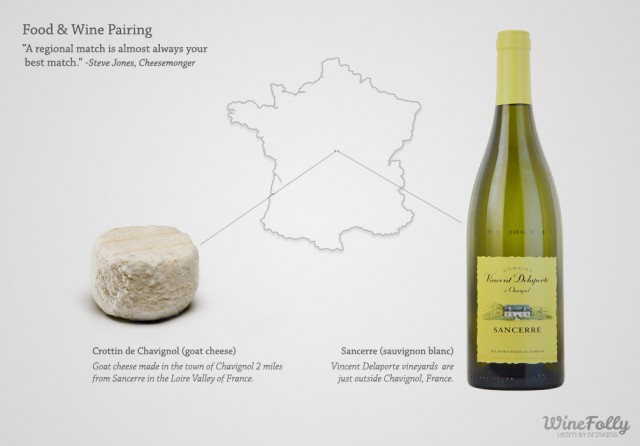It turns out there are 6 main basic flavor profiles that you can experiment with to develop a great food and wine pairing. In this article, we take a look at the fundamental flavor profiles for food and wine pairing, as well as the regional pairing example and why it works. Learn to match food and wine like a professional chef or sommelier.

The 6 Basics to Food and Wine Pairing
I was half asleep in the morning in a dark Michael Mina Restaurant until Chef Mike boomed in his signature snide-but-charismatic voice, [superquote]”Cooking is simply a balance of fat, acid, salt and sweet.”[/superquote] At the time, I was not a glorious writer of hedonism (aka wine), but part of the service staff gleaning knowledge on how to sell food. What Mina touched on struck a chord and helped me to isolate what I need to go about constructing a food and wine pairing. The basics of flavor-matching are actually quite simple (although not always easy to pull off). These are the 6 basic profiles to work with when thinking about matching food and wine:
- Acidity in wine pairs well with fatty and sweet foods.
- Fatty foods need either an acidic or high alcohol wine. Otherwise, the wine will taste flabby.
- Bitter (aka Tannic) wine can be balanced with sweet food.
- Salty shouldn’t compete with acidity in a wine. Use sparingly as necessary to keep sharpness in the meal.
- Sweet food/wine benefits from a little acidity.
- Alcohol can be used to cut through fatty foods or balance a sweet dish.

Common Food and Wine Pairing Techniques
Regional Pairing
The idea of a regional pairing is pretty fundamental. Imagine Italian wine and Italian food or an Oregon pinot noir with a cows milk cheese from the Willamette Valley. Regional matches aren’t always the perfect pairing. However, they provide a template for us to understand more about what’s going on structurally with wine & food pairings.
Acid + Acid
Unlike bitter, acidity can be added together with food and wine and will create the basis of what wine people think about when selecting a wine with dinner. If the wine has less acidity than the food, the wine will taste flat. An easy visualization for acids out-of-balance is a glass of oaked warm climate chardonnay with a vinaigrette salad. When pairing a dish with wine, consider the acid balance between the food and the wine.
Sweet + Salty
If you love maple bacon, candied pecans and salted caramels, a wine and food pairing of a sweet wine with a salty food will probably delight you. Pair Riesling with Asian foods such as fried rice or Pad Thai, or try one of my favorite “low calorie” desserts of pretzels and tawny port.
Bitter + Fat
Grab a big thick piece of fatty something-or-other and pair it with a wine with lots of tannin. This is the classic steak with red wine food pairing, and I think we can do better than that. Take a red wine such as an Italian Sangiovese with lots of cherry flavors and pair the wine with an herbed potato croquette, roasted red tomatoes, and rocket (a classic Tuscan Secondi). Suddenly you have a dish that has the tannin balanced with the fat in the croquette and a harmonious flavor in the dish and wine (tomato and cherry) that elevate each other. I’m already drooling.
Acid + Fat
Nothing like a glass of champagne to cut the fat. A high acid drink will add a range of interesting flavors to a heavy lipid dish. This is why white wine butter sauce is popular (you can watch a video of How to Make Buerre Blanc if you’d like) The white wine in the butter sauce livens up the whole dish. So when you are in a situation where there is something fatty like cheesecake, get a glass of something bubbly and zippy.
Alcohol + Fat
The alcohol category is a bit of a strange one. The alcohol taste comes across as acidity, so a lot of the same ideologies of the Acid + Fat category pass over into Alcohol + Fat. The primary difference is that a high alcohol drink should not be used as a palate-cleanser because that will eff you up. Instead, look at an alcohol + fat category as a way to mitigate high-speed food consumption. A glass of 17% ABV zinfandel will greatly slow down the rate at which you consume your pepper steak. I use the alcohol + fat category often for dessert pairing, but I’d like to see it more in dining as we learn to eat slower and enjoy longer.
